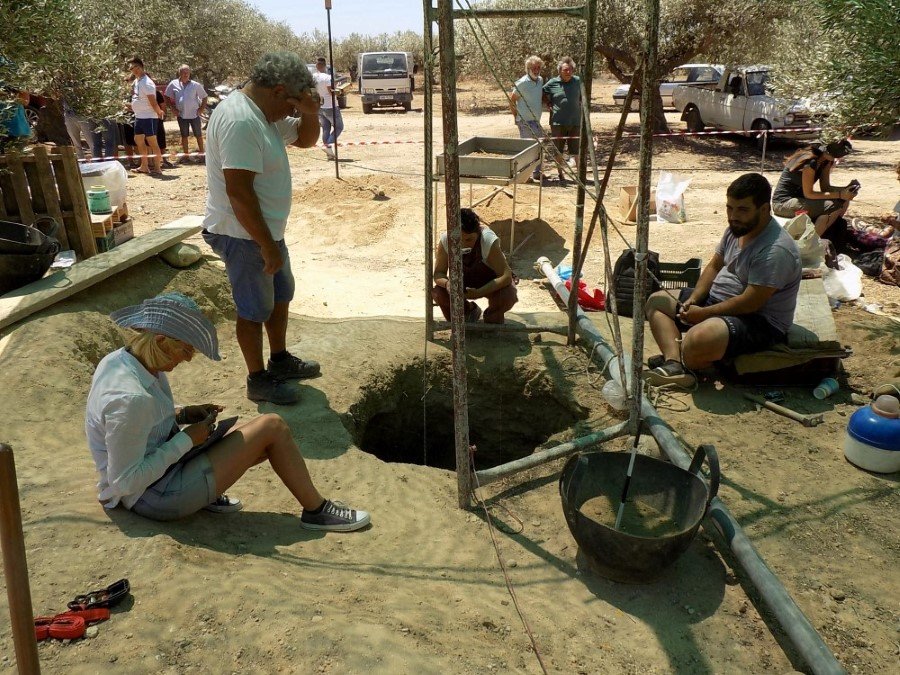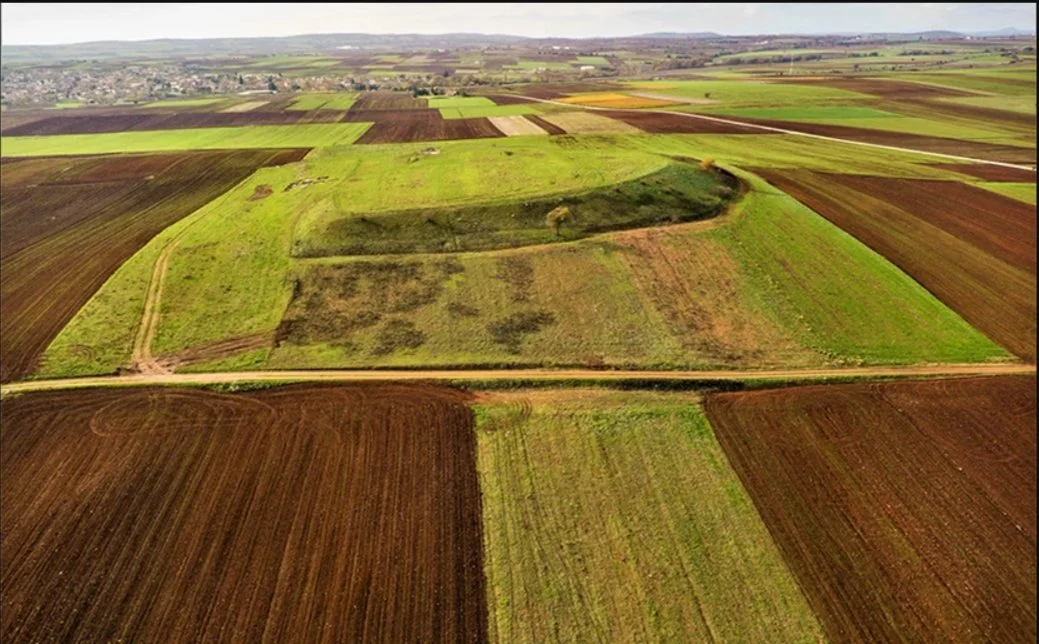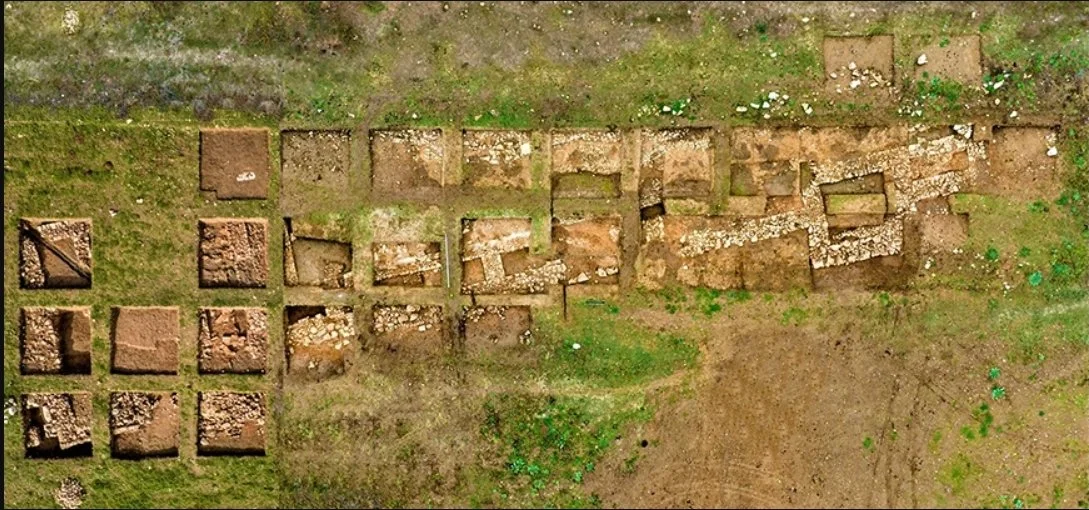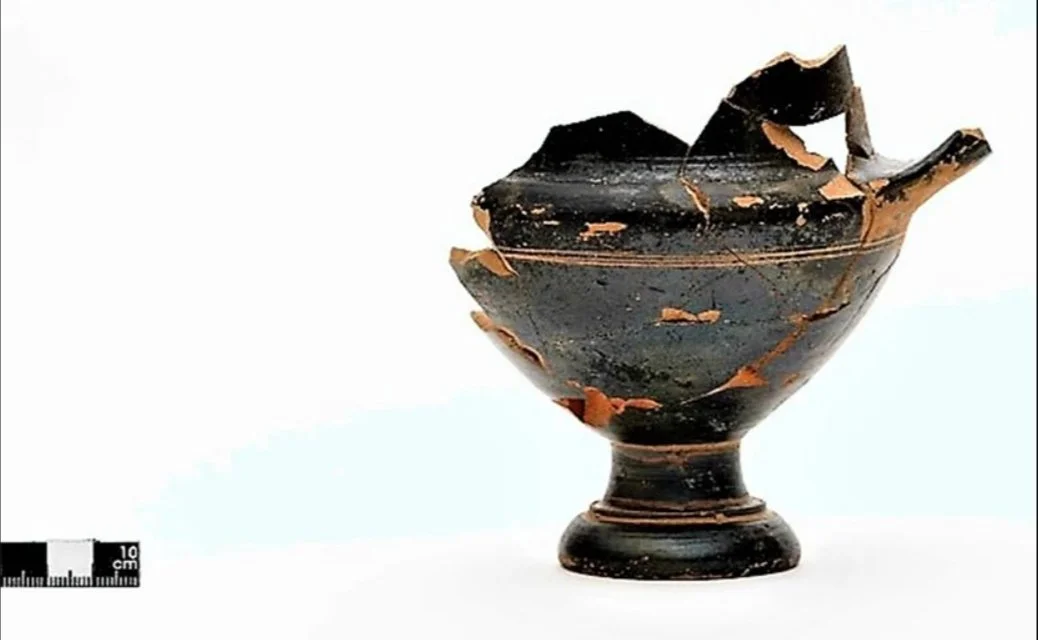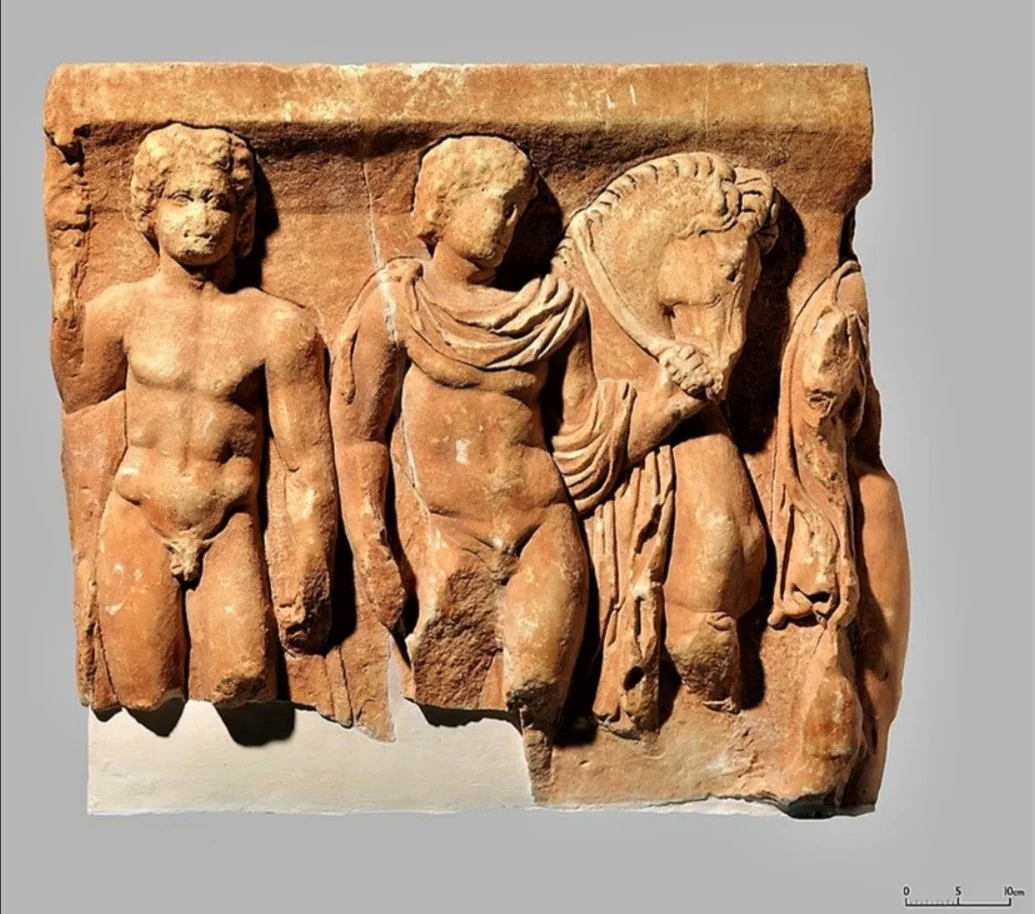For thousands of years, the Paiute people have made the Pyramid Lake Indian Reservation their home. It’s an area steeped in Native American history and has long been a source of fascination for experts. However, nobody knew just how unusual this area was until a single geologist stumbled upon some strange-looking boulders where Winnemucca Lake once stood. And once the curious scientist decided to get a closer look, he quickly realized there was no going back.
Greek Farmer Accidentally Discovers 3,400-Year-Old Minoan Tomb Hidden Under Olive Grove
Sometime between 1400 and 1200 B.C., two Minoan men were laid to rest in an underground enclosure carved out of the soft limestone native to southeast Crete. Both were entombed within larnakes—intricately embossed clay coffins popular in Bronze Age Minoan society—and surrounded by colorful funerary vases that hinted at their owners’ high status. Eventually, the burial site was sealed with stone masonry and forgotten, leaving the deceased undisturbed for roughly 3,400 years.
On 2018, a local farmer accidentally brought the pair’s millenia-long rest to an abrupt end, George Dvorsky reports for Gizmodo. The farmer was attempting to park his vehicle beneath a shaded olive grove on his property when the ground gave way, forcing him to find a new parking spot. As he started to drive off, the unidentified local noticed a four-foot wide hole that had emerged in the patch of land he’d just vacated. Perched on the edge of the gaping space, the man realized he’d unintentionally unearthed “a wonderful thing.”
According to a statement, archaeologists from the local heritage ministry, Lassithi Ephorate of Antiquities, launched excavations below the farmer’s olive grove at Rousses, a small village just northeast of Kentri, Ierapetra, in southeast Crete. They identified the Minoan tomb, nearly perfectly preserved despite its advanced age, in a pit measuring roughly four feet across and eight feet deep. The space’s interior was divided into three carved niches accessible by a vertical trench.
In the northernmost niche, archaeologists found a coffin and an array of vessels scattered across the ground. The southernmost niche yielded a second sealed coffin, as well as 14 ritual Greek jars called amphorae and a bowl.
Forbes’ Kristina Kilgrove writes that the high quality of the pottery left in the tomb indicates the individuals buried were relatively affluent. She notes, however, that other burial sites dating to the same Late Minoan period feature more elaborate beehive-style tombs.
“These [men] could be wealthy,” Kilgrove states, “but not the wealthiest.”
Unlike many ancient tombs, the Kentri grave was never discovered by thieves, Argyris Pantazis, deputy mayor of Local Communities, Agrarian and Tourism of Ierapetra, tells local news outlet Cretapost. In fact, the site likely would have remained sealed in perpetuity if not for the chance intervention of a broken irrigation pipe, which watered down the soil surrounding the farmer’s olive grove and led to his unexpected parking debacle.
“We are particularly pleased with this great archaeological discovery as it is expected to further enhance our culture and history,” Pantazis added in his interview with Cretapost. “Indeed, this is also a response to all those who doubt that there were Minoans in Ierapetra.”
According to Archaeology News Network, most Minoan settlements found on Crete are located in the lowlands and plains rather than the mountainous regions of Ierapetra. Still, a 2012 excavation in Anatoli, Ierapetra, revealed a Minoan mansion dating to between 1600 and 1400 B.C., roughly the same time period as the Kentri tomb.
This latest find offers further proof of the ancient civilization’s presence—as Mark Cartwright notes for Ancient History Encyclopedia, the Minoans are most renowned for their labyrinthine palace complexes, which likely inspired the classic Greek myth of Theseus and the Minotaur. According to legend, Queen Pasiphae of Crete gave birth to the Minotaur, a fierce half-man, half-bull hybrid, after falling for a bull sent to Earth by the Greek god Zeus. The Minotaur, doomed to an eternity spent wandering the halls of an underground labyrinth and killing anyone it encountered, was eventually defeated by the demigod Theseus, who relied on an enchanted ball of thread provided by the king’s daughter, Ariadne, to escape the maze.
Much of the Minoans’ history remains unclear, but Forbes’ Kilgrove reports that natural disasters, including the eruption of the Thera volcano, an earthquake and a tsunami, contributed to the group’s downfall, enabling enemies such as the Mycenaeans to easily invade. Analysis of the excavated Kentri tomb may offer further insights on the Minoan-Mycenaean rivalry, as well as the Cretan civilization’s eventual demise.
Archaeologists in Peru uneагth Eight Colonial Era Skeletonѕ
Archaeologists in Peru have unearthed eight centuries-old mummies at a site in the country's capital, an important find that experts say could point a colonial-era cemetery.
Archaeologists on October 2022 were hard at work in Lima's Park of Legends on the coast of central Peru, carefully cleaning the ancient preserved corpses found under the site, including the remains of children.
Park official Lucenida Carrion said the latest find follows an earlier discovery of three mummies, one of which was holding a wooden cross, in early August 2022.
"This finding backs our hypothesis that this could be cemetery from the colonial period, at the time of conversion to Christianity or Catholicism," she said.
The mummies were found in unusual positions and with a mix of textiles that pointed to the influence of Spanish colonials, added field manager Manuel Moron.
Spain's bloody conquest of Peru's Inca empire began in 1532 and lasted four decades. Government officials said the site had been occupied by the Lima and Ychsma people before the Incas.
Other monuments discovered at the same site date back some 2,000 years.
Kilkis, Greece: An ancient city with a wall of at least 4 meters was discovered
During an archaeological excavation, an ancient city was uncovered at the gates of the city of Kilkis, between the communities of Kampanis and Pedinos of the municipality of Kilkis. The hoe unearthed a wall at least four meters high, which surrounded a city with a dense urban fabric. The base of the wall, about 5.5 meters wide, consists of a stone base and the rest consists of bricks covered with tiles.
Today, if you leave the prefecture of Thessaloniki behind and drive towards Kilkis, in the south of the prefecture, just after Nea Santa, you will see a series of hills which, if you are not familiar with them, you might think are natural hills. However, several of them are hills with a trapezoidal top. In the language of archaeologists, they are called "banks" with settlement remains, formed from the overlapping layers of ancient settlements.
In 2018, archaeologist and head of the Antiquities Department of Kilkis, Dr. Georgia Stratouli, and archaeologist Dr. Nektarios Poulakakis, head of the Department of Prehistoric and Classical Antiquities of the Antiquities Department of Kilkis, visited a site that has been proclaimed since the 1980s and is protected by the Archaeology Law. During their tour there, they found, among other things, broken pieces of vases on the surface, which they "read" to make an initial estimate of their dating.
"It was in November 2018 when we first conducted a targeted surface survey on the prominent Kampanis Pedinos bank and we realized we were stepping on a wall," Georgia Stratoulis told the Athenian-Macedonian News Agency. "We immediately decided not only to use the possibilities of excavation investigation, but also to carry out a geophysical survey of the soil, i.e. a method of scanning the ground, with the help of qualified researchers and special machines," he added.
This was done in collaboration with the Aristotle University of Thessaloniki, in particular with the Geophysical Research Laboratory headed by Professor Grigoris Tsokas, who proved the existence of a wall that surrounded an ancient city with a dense urban organization. "It is very important to find a fortified city from the Hellenistic and Roman periods in the interior of Central Macedonia, because we do not know many cities that have preserved their fortifications. From the synopsis and the lore registered from time to time in the Archaeological Museum of Kilkis, it is clear that it is an ancient city that dates back at least to the 4th century BC. Moreover, based on the geophysical surveys, we have the certainty that there are public spaces outside the wall and very close to it, which we intend to uncover in the next excavation periods", he stresses.
What came to light and what are the further plans
In the small and temporary excavations in 2021 and 2022, with only 130,000 euros and a single-digit number of craftsmen, the monumental central gate of the ancient city, on the south side of the wall, and about 60 meters of the southeastern section were uncovered. In addition, a square tower was uncovered about 30 meters east of the gate, while, as Ms. Stratouli estimates based on geophysical analysis, there will almost certainly be another to the west of the gate. "We have at least five or six towers that we recognise from the geophysical survey, with the possibility of another semicircular tower in the SE corner of the wall," he says.
In the near future, Ms. Stratouli and her team will submit applications for a more systematic excavation of the wall's perimeter, so that at least the southern and eastern sides of the wall will soon be visible. Indeed, these sides will be visible from the Thessaloniki-Kilkis provincial road that passes through the settlements of Mandres and Kampanis. "Apart from the excavations, we want to make the already exposed part of the wall visible. It could be partially restored by conventional means or with the use of modern technology. If we manage to deploy at least two excavation teams in 2023, we could complete the exposure of the entire southern wall and extend it to the eastern side in the next two years", said Ms. Stratoulis.
As Ms. Stratouli says, the desired goal is that the Ephorate of Antiquities, with the support of the Ministry of Antiquities, can gradually shape a new emblematic archaeological site that will contribute to the development of Kilkis and Central Macedonia.
Researchers Make an Unexpected Discovery! There Is a Huge Forest in This Hole in China!
We are always launching new technologies and launching complex space telescopes into space that look deeper than ever into the mysteries of the cosmos - even though we still have no idea what's really going on on our blue home planet! So we can currently only speculate about the traces of civilization and creatures that hide in the secluded deep sea or in the heart of the jungle. Together with you we would like to shed some light into the earthly darkness today: We look at several rare natural discoveries that impressively show us the diversity and beauty of our earth.
FIRST MEETING OF REMOTE VILLAGERS || Vanuatu- Part 2
This episode we truly have an experience like no other. Being "welcomed" onto a remote island in Northern Vanuatu. A greeting party like nothing we have ever seen- this is about as wild as it gets. It's these moments in life that really change your perception on how to see the world.
Acrocanthosaurus | The King of Early Cretaceous North America
When you think, North America and giant carnivores, the T. rex is almost certainly going to be the first dinosaur that comes to mind. However, millions of years before the legend itself, another theropod was ruling North America, and it wasn’t even a Tyrannosaur! It was the Acrocanthosaurus. It was an apex predator that dominated the lands and had a knack for going after armored Ankylosaurs and even massive sauropods, taking on the likes of Astrodon and possibly the Sauroposeidon .
Archeologists Scouring Turkey’s Largest Lake Uncovered A Mysterious Long Lost Kingdom
A group of underwater explorers went on their usual adventure in Turkey's Largest Lake depths and discovered something amazing and unimaginable. They found a long-lost kingdom. Surprising right? It seems like a miracle, as a team of researchers has discovered a lost 3,000-year-old castle in Turkey's Lake Van.
'Staircase To Nowhere' Appears In Giza Plateau?
Has a 'staircase to nowhere' appeared in Giza Plateau? Watch the video for more!
1.7 Billion Year Old Nuclear Reactor Found?
In the video below we will investigate whether an 1.7 billion year old nuclear reactor has been found. Enjoy!
Lost Roman Map has Atlantis at Eye of Sahara Africa!
Astonishing new details have been uncovered involving the Lost Ancient City of Atlantis, and the Eye of The Sahara. These details are so significant that the Richat Structure should without a doubt, be considered the most likely location of the lost capital city of Atlantis.
The Most Mysterious Ancient Archaeological Discoveries
We will now discuss about the most mysterious ancient archaeological discoveries. Watch the video and enjoy!
12 Most Mysterious Ancient Egypt Finds Scientists Can't Explain
In the following video we will go through the 12 most mysterious Ancient Egypt finds that scients can’t explain. Enjoy!
Saudi Arabia Just SHOCKED American Scientists With This
In the video below we will be talking about how Saudi Arabia just shocked American scientists. Enjoy!
The tragic life & death of Cleopatra | Dark history they never told you about
Many of us have read or heard about history’s one of the most gorgeous ladies. Yes, we are talking about the history and biography of Cleopatra. It all looks like love and roses, right?
But let us unravel some dark history for you and tell you about Cleopatra’s horrible history, the tragedies she had to face, and how she fell prey to the angel of death. In this video, we dug up some hidden archives from Egyptian history and bring you this absolute master peace that would take you into the roller coaster of Cleopatra’s love story and tragic death.
TREASURES Buried In The Hidden Tombs Of Egypt Are FINALLY Found
Egyptian discoveries never fail to surprise us. And there is no doubt why the Egypt pyramids are considered one of the world's wonders. Egypt, once ruled by enormously strong Pharaohs, eventually fell under many dynasties over the course of several centuries. And ancient Egypt's dynasties were lost behind the following layers of these varied cultures. But now these secrets and treasures of Egypt's buried tombs are being uncovered.
DISTURBING Evidence Found In Egyptian Hidden Tomb
Have you ever been curious about what was discovered in an Egyptian tomb? The artifacts and relics they unearthed will astound, perplex, and perhaps even upset you as you watch the whole video. You're at A SECRET WORLD, where you will find all the evidence found in the Egyptian hidden tombs.
While thankfully no one died, we think this one deserves its position on our list. It should not have come as a surprise that Sir Bruce Ingham received gifts from his buddy Howard Carter because Sir Bruce Ingham was Howard Carter's friend; yet, this particular gift was a little unsettling.
Mahabharata Family Tree
In the video below we will be talking about the Mahabharata family tree. Enjoy!
12 Most Mysterious Finds Scientists Still Can't Explain
Not everything that’s found by archaeologists can be adequately explained by scientists. That’s because our understanding of history is incomplete. In some cases, there are enormous holes in it. We can speculate all we like about how or why our ancient ancestors made some of the things they built, but we might never get the full picture. Experts are still stumped about several of the things you’re about to see in this video!
Rare Archaeological Discoveries
In the video below we will be exploring rare archaeological discoveries. Watch the video for more!





